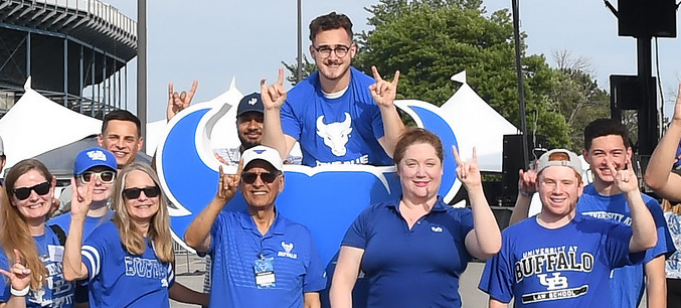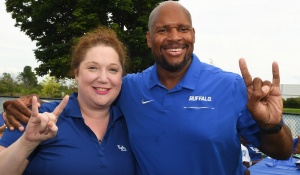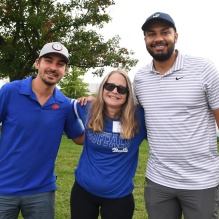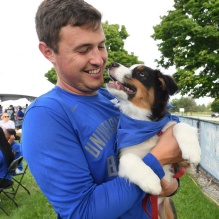
Sports Law Center takes on emerging issues
Responding to recent developments in the world of athletics, UB’s Center for the Advancement of Sport is directing its students’ energies towards emerging issues that are changing the face of the game.
“It’s very exciting to see the program continue to grow and develop,” says Professor Helen “Nellie” Drew '88, who directs the interdisciplinary center and is committed to engaging students in shaping the future of the industry.
Drew conducted extensive research in collaboration with her former student, Marissa Egloff '22, on Title IX and the limited progress of women and people of color in managerial or executive roles in professional sports. That research was the foundation for a journal article that Drew will present next month at a symposium on sports and social justice issues hosted by the Journal of Race, Gender and Social Justice at William & Mary Law School.
Drew's enthusiasm for the world of sports is shared by the growing number of UB Law students pursuing careers in sports law, many of whom post regularly in the UB Law Sports & Entertainment Forum; an online forum for the discussion of current issues in the industry. Several students are also pursuing the law school’s concentration in sports law, designed to equip them with the special expertise needed to address the wide range of legal matters related to professional and amateur sports.
Monetizing and regulating “name, image and likeness”

Dean Aviva Abramovsky and Mark Alnutt, UB Director of Athletics
As part of their work in the law school’s sports law program, three third-year law students—Connor Johnson, Michael Perlo and Joseph O’Bryan—submitted a research paper to the MIT Sloan Sports Analytics Conference and were selected to participate in the conference to be held in Boston in March.
Their research is an early look at how male and female student athletes—in this case basketball players in the Big Ten—are faring in monetizing their “name, image and likeness,” or NIL. After the U.S. Supreme Court ruled in 2021 that the National Collegiate Athletic Association cannot limit “education-related benefits” for college athletes, some athletes have profited from licensing deals with advertisers. The students’ research shows that the male basketball players secured more deals and more money than the female players.

Christopher J. Kolber '23, Nellie Drew '88, and Jake Cercone '21
Solid information was hard to come by, Johnson says, because colleges aren’t required to report NIL deals. “This whole thing is in its infancy stage,” he says. “It’s a brand-new world.”
Johnson, who’s also president of the Buffalo Sports & Entertainment Law Society, adds that NIL deals have introduced new challenges for athletic departments. For example, the NCAA has said schools can’t use the prospect of these deals as a recruiting tool, but some athletes are transferring between programs for the chance to join a team’s starting roster and get an endorsement deal.
Helping UB get a handle on NIL deals has been a focus for two third-year students in the sports law program, Grace Ponterio and Charles Desmond. They spent the fall semester as externs with the Compliance Office of UB’s Department of Athletics, working on crafting policies and protocols to keep the university in compliance with state, NCAA and UB regulations. “When we started,” Ponterio says, “it was like the wild, wild West. There were no rules.”
Then, in late November, Gov. Kathy Hochul signed the New York Collegiate Athletic Participation Compensation Act, allowing college athletes to enter into NIL deals without jeopardizing their scholarships. “That gave us an opportunity to continue and expand on our work,” Ponterio says. They’re doing so in a spring-semester practicum in which they’ll continue their work to establish clear regulations.

Connor Johnson '23 with the Buffalo Sports and Entertainment Law Society (BSELS) mascot, River.
Powerhouse athletic schools like Alabama and Ohio State have entire departments handling NIL issues, Desmond says. “We use their guidelines to learn about the process that goes into NIL as well as give us a basis for the guidelines we want to set for our university.
“One issue we deal with is the schools intellectual property rights,” Desmond says. “When students want to take part in an NIL deal and want to use the schools IP, they need to get it approved with the Intellectual Property office. If they don’t, that’s where the school and the student might run into issues. We are working with the compliance office and University to simplify this process for our student athletes and over the next few months we hope to have made some advancements.”
Developing best practices and expanding education
Part of a practicum, students are also looking at injury data from the National Football League as it relates to turf fields vs. natural grass, and the impact of short turnaround times between games. The aim, Drew says, is to propose a set of best practices for youth sports based on that information.
The center is also collaborating with UB’s Institute for Computational and Data Sciences to present a series of online courses to build employable skills in the sports industry. Drew says the courses are intended for elite athletes, such as hockey players, who need help transitioning to the next phase of their careers once their playing days are over.
And Erie County Executive Mark Poloncarz has reached out to the center for its assistance in preparing a summary of the new football stadium deal in Buffalo recently approved by the Erie County Stadium Corp. Students will have an opportunity to work with the county to help educate the community and address any misinformation regarding the details of the agreement.